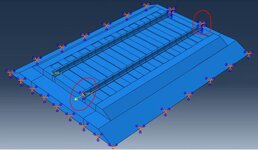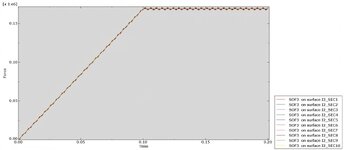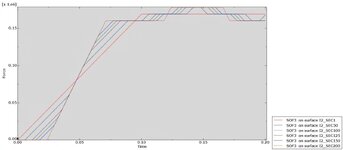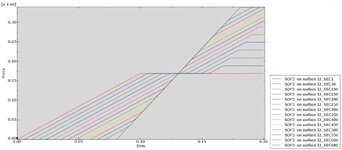Hello everyone,
I’m working on a 3D simulation of a railroad track in ABAQUS using a dynamic/explicit analysis to investigate the longitudinal behavior of the rail. My model consists of multiple steps. In the first step, I apply a tensile force at one end of the rail, while the opposite end is fixed in the axial direction (see Figure 1). The force is applied using a linear amplitude over 0.1 seconds, followed by an additional 0.1 seconds to allow the system to stabilize.
The objective of this step is to generate uniform axial tension along the rail equal to 170 kips. This approach works well for short models (i.e., with a small number of crossties). For example, in a model with 10 crossties, cross-sectional force measurements show consistent axial force along the rail length (see Figure 2).
However, when I extend the model to include 200 or 680 crossties, the axial forces are no longer uniform along the rail (see Figures 3 and 4). The axial force in the middle cross sections continues to increase and then fluctuates around values higher than the intended tension. Since my ultimate goal is to simulate a long section of track, I would appreciate any guidance on how to achieve and maintain uniform axial tension in longer models.
Any suggestions or insights would be greatly appreciated.
Figure 1. Railroad track model

Figure 2. Model with 10 crossties

Figure 3. Model with 200 crossties (only few number of cross-sectional forces have been shown)

Figure 4. Model with 680 crossties (only few number of cross-sectional forces have been shown)

I’m working on a 3D simulation of a railroad track in ABAQUS using a dynamic/explicit analysis to investigate the longitudinal behavior of the rail. My model consists of multiple steps. In the first step, I apply a tensile force at one end of the rail, while the opposite end is fixed in the axial direction (see Figure 1). The force is applied using a linear amplitude over 0.1 seconds, followed by an additional 0.1 seconds to allow the system to stabilize.
The objective of this step is to generate uniform axial tension along the rail equal to 170 kips. This approach works well for short models (i.e., with a small number of crossties). For example, in a model with 10 crossties, cross-sectional force measurements show consistent axial force along the rail length (see Figure 2).
However, when I extend the model to include 200 or 680 crossties, the axial forces are no longer uniform along the rail (see Figures 3 and 4). The axial force in the middle cross sections continues to increase and then fluctuates around values higher than the intended tension. Since my ultimate goal is to simulate a long section of track, I would appreciate any guidance on how to achieve and maintain uniform axial tension in longer models.
Any suggestions or insights would be greatly appreciated.
Figure 1. Railroad track model

Figure 2. Model with 10 crossties

Figure 3. Model with 200 crossties (only few number of cross-sectional forces have been shown)

Figure 4. Model with 680 crossties (only few number of cross-sectional forces have been shown)

